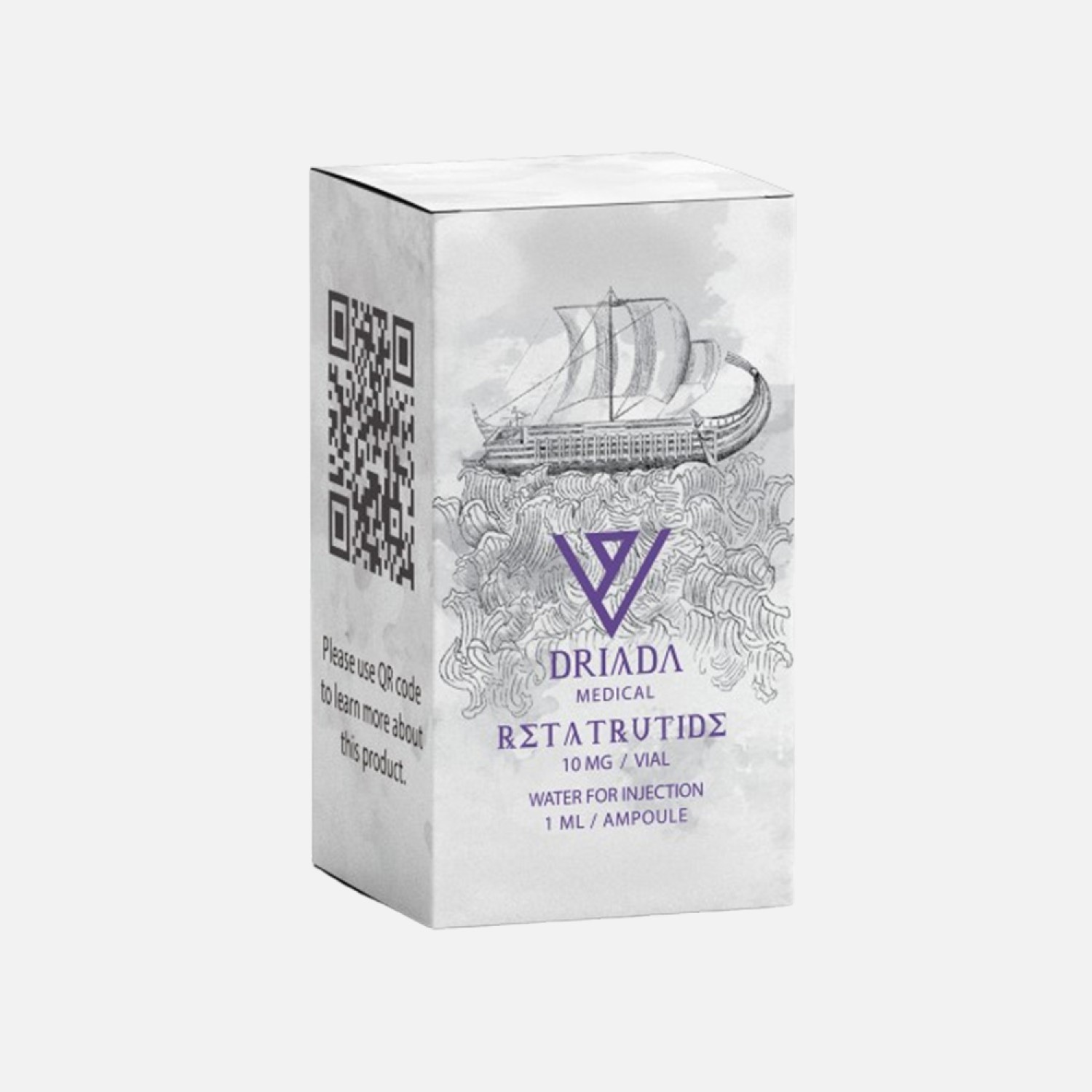
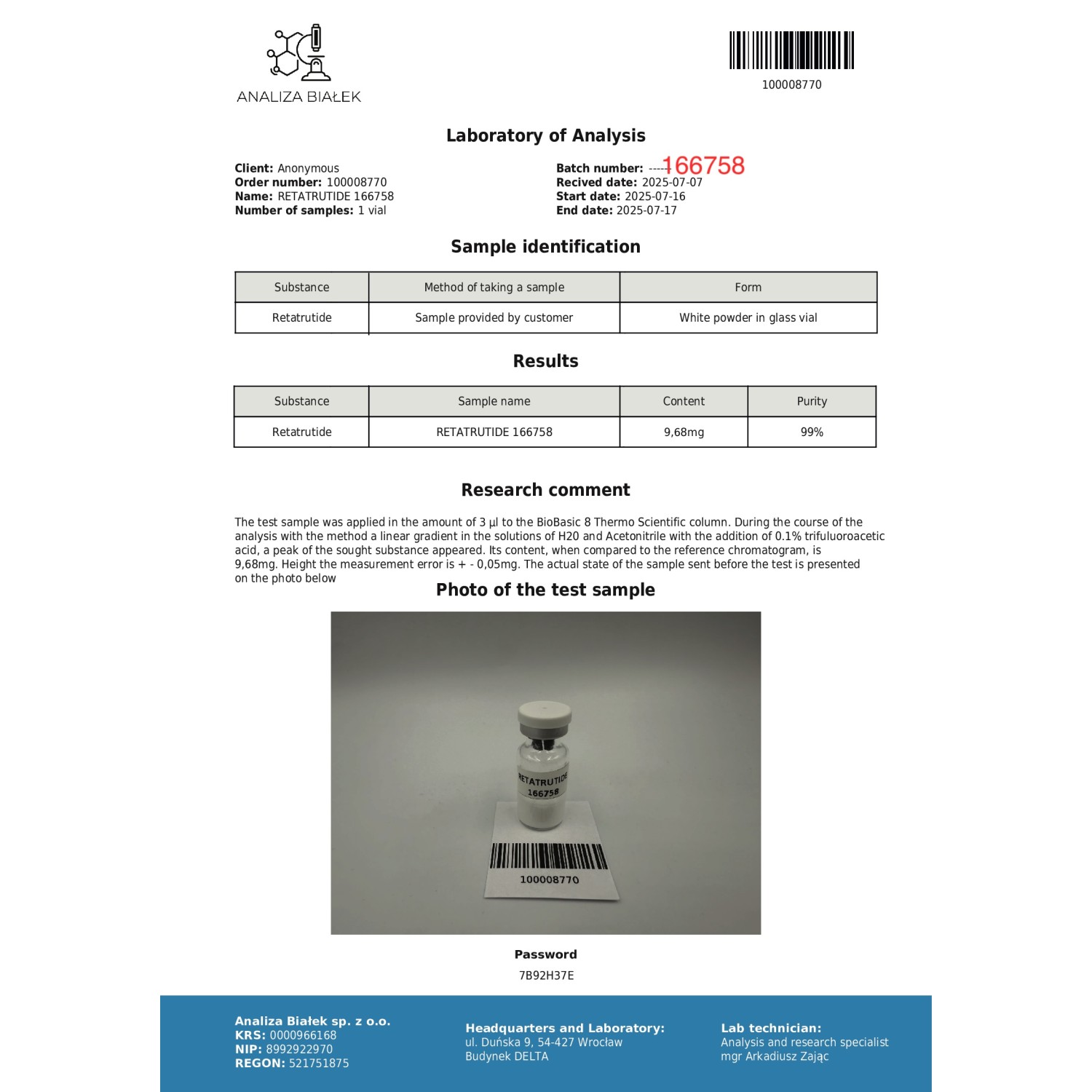


- Verfügbarkeit: Nicht vorrättig
- Package: 10mg/vial+water
This offer ends in:
- Zusammensetzung: Retatrutide 10 mg
- Kategorie: Peptid
- Verwendungszweck: Gewichtsverlust
- Form: Fläschchen mit lyophilisiertem Pulver + 1 ml Ampulle mit bakterizidem Wasser zur Rekonstitution
- Verabreichung: Subkutane Injektionen
Was ist Retatrutide?
Retatrutide ist ein experimentelles, peptidbasiertes Medikament, das für Gewichtsverlust und metabolische Normalisierung entwickelt wurde. Es wirkt durch einen dreifachen Mechanismus, indem es die GLP-1-, GIP- und Glukagon-Rezeptoren aktiviert — Hormone, die den Appetit, den Blutzucker und den Energieverbrauch regulieren. Diese einzigartige Kombination macht es derzeit zu einem der vielversprechendsten neuen Kandidaten für die Behandlung von Adipositas und Stoffwechselstörungen.
Und nun ist Retatrutide endlich in unserem Shop erhältlich für diejenigen, die sein Potenzial aus erster Hand erkunden möchten.
Wer kann von Retatrutide profitieren?
✓ Wenn Sie Gewicht verlieren und Ihren Appetit kontrollieren möchten, ohne extreme Diäten oder Hungern — Retatrutide reduziert den Appetit und verlängert das Sättigungsgefühl, was Ihnen hilft, weniger zu essen und bequem überschüssiges Gewicht abzubauen.
✓ Wenn Sie Insulinresistenz, ein metabolisches Syndrom oder Prädiabetes haben — das Medikament verbessert die Insulinsensitivität und unterstützt die Blutzuckerregulation.
✓ Wenn Sie an Adipositas und verwandten Erkrankungen wie hohem Blutdruck, Müdigkeit oder Entzündungen leiden — Retatrutide hilft, die Belastung der inneren Organe zu verringern und verbessert Ihr metabolisches Profil.
✓ Wenn bei Ihnen Typ-2-Diabetes diagnostiziert wurde — es kann helfen, den Blutzuckerspiegel besser zu kontrollieren, Heißhunger zu reduzieren und als zusätzliches therapeutisches Hilfsmittel dienen.
✓ Wenn Sie Fettlebererkrankungen vorbeugen möchten — Retatrutide kann den Leberfettgehalt senken und systemische Entzündungen reduzieren.
Wie nimmt man Retatrutide ein?
Retatrutide wird in einem Fläschchen mit 10 mg lyophilisiertem Pulver geliefert. Es muss vor der Verwendung mit dem bereitgestellten bakteriziden Wasser rekonstituiert werden. Detaillierte Anweisungen zur Zubereitung von Peptiden und zur Durchführung von Injektionen finden Sie HIER.
Dosierungsplan
| Schritt | Wöchentliche Dosis | Zeitraum | Hinweise |
|---|---|---|---|
| Start | 2,5 mg | Wochen 1–4 | Zur Anpassung und für weniger Nebenwirkungen |
| Erste Erhöhung | 5 mg | Wochen 5–8 | Wenn gut verträglich |
| Optionaler Schritt | 7,5 mg | Wochen 9–12 | Hinzufügen, wenn mehr Wirkung benötigt wird |
| Üblicher Bereich | 10–12,5 mg | Nach Woche 12 | Die meisten bleiben hier für einen langfristigen Nutzen |
| Maximum | 15 mg | Bis das Ziel erreicht ist | Nur, wenn niedrigere Dosen nicht wirken und gut verträglich sind |
- Einmal pro Woche verabreichen, jeweils am gleichen Tag
- Vor der Injektion die Lösung visuell überprüfen (sie sollte klar sein, ohne Partikel oder Ablagerungen)
- Wenn Übelkeit oder Schwäche auftritt, die Dosiseskalation verlangsamen oder eine Pause von 1 Woche einlegen
Gegenanzeigen und Vorsichtsmaßnahmen
- Nicht verwenden, wenn Sie eine familiäre Vorgeschichte von medullärem Schilddrüsenkrebs oder MEN2-Syndrom haben
- Vorsicht bei Pankreatitis, Gallenblasenerkrankungen oder Schilddrüsenerkrankungen
- Nicht mit Medikamenten kombinieren, die die Magen-Darm-Motilität verlangsamen, ohne ärztlichen Rat
Mögliche Nebenwirkungen
- Übelkeit (besonders in den ersten Wochen)
- Appetitverlust
- Blähungen, Gas, weicher Stuhl oder Verstopfung
- Müdigkeit, Kopfschmerzen
- Selten: erhöhte Pankreasenzyme, Bauchschmerzen (absetzen, wenn starke Schmerzen auftreten)
Wie lagern?
- Das Produkt im Kühlschrank bei 2–8 °C (36–46 °F) aufbewahren.
- Nicht einfrieren.
- Vor Licht schützen.
- Häufige Temperaturschwankungen vermeiden (z. B. wiederholtes Herausnehmen aus dem Kühlschrank).
- Nach der Rekonstitution im Kühlschrank aufbewahren und innerhalb von etwa einem Monat verwenden.
Wie wirkt Retatrutide?
Retatrutide wirkt auf drei wichtige hormonelle Rezeptoren, die an der Nahrungsaufnahme und der metabolischen Regulation beteiligt sind: GLP-1, GIP und der Glukagonrezeptor. Ihre kombinierte Aktivierung führt zu einer Appetitzügelung, verbessertem Glukosemanagement und verstärktem Fettabbau.
GLP-1
GLP-1 (glucagonähnliches Peptid-1) ist ein Hormon, das nach dem Essen vom Darm ausgeschüttet wird. Es signalisiert dem Gehirn, dass der Körper genug Nahrung aufgenommen hat, was das frühe Sättigungsgefühl fördert und den Hunger für mehrere Stunden verringert. Es verlangsamt auch die Magenentleerung, was das Sättigungsgefühl verlängert.
Über die Appetitkontrolle hinaus regt GLP-1 die Bauchspeicheldrüse dazu an, Insulin genau dann freizusetzen, wenn der Blutzuckerspiegel steigt — besonders wichtig für Menschen mit Insulinresistenz. Es senkt auch die Glukagonfreisetzung, ein Hormon, das den Blutzuckerspiegel anhebt. Dieser doppelte Mechanismus hilft, das richtige metabolische Gleichgewicht bei Menschen mit Übergewicht oder Stoffwechselstörungen wiederherzustellen.
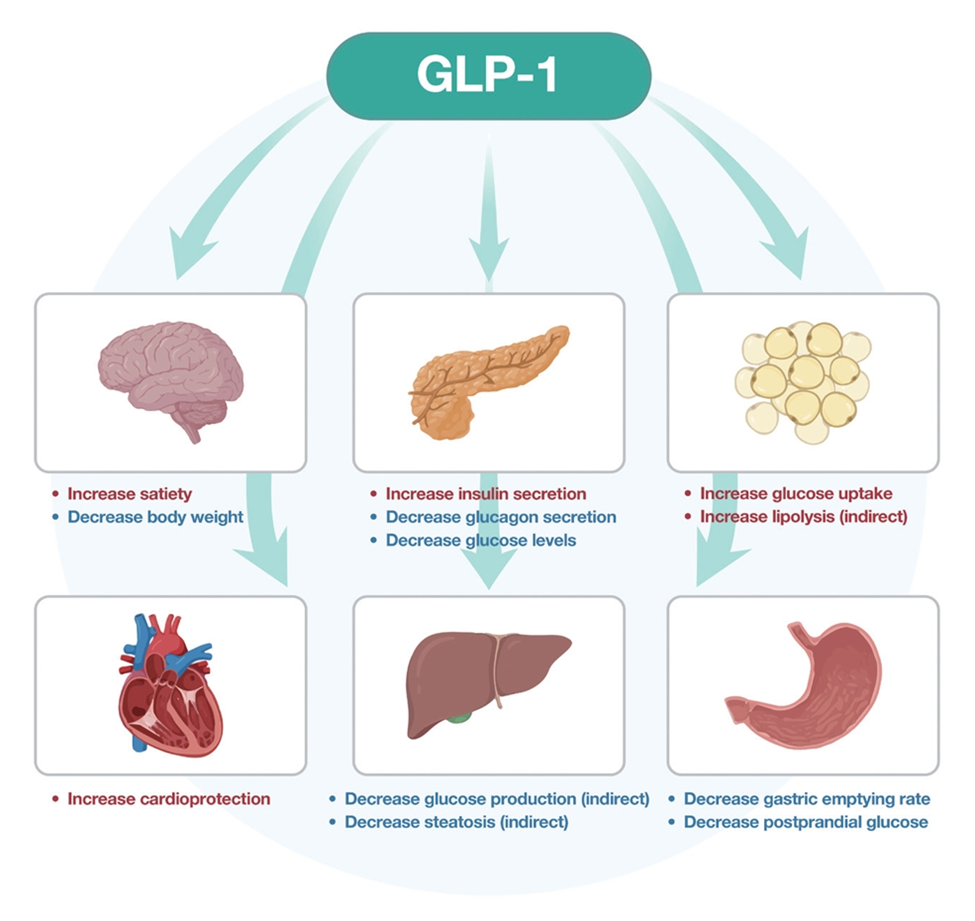
GIP
GIP (glukoseabhängiges insulinotropes Peptid) ist ein weiteres Hormon, das nach den Mahlzeiten freigesetzt wird. Es hilft, den Blutzuckerspiegel zu regulieren, aber auf eine andere Weise als GLP-1. GIP verstärkt die Insulinantwort des Körpers, insbesondere nach dem Verzehr von Kohlenhydraten und Fetten.
Es fördert die Insulinproduktion und verbessert die Fähigkeit der Zellen, Glukose aufzunehmen, wodurch deren Nutzung für Energie anstatt deren Verbleib im Kreislaufsystem gefördert wird. Anhaltend hoher Blutzucker kann die Bauchspeicheldrüse überlasten, systemische Entzündungen erhöhen und die Fettansammlung beschleunigen — alles Faktoren, die das Risiko für Diabetes erhöhen. GIP unterdrückt auch die hepatische Glukoseproduktion und kann den Lipidstoffwechsel regulieren, indem es die Fettspeicherung einschränkt.
Interessanterweise hat GIP alleine nur begrenzte Auswirkungen, aber in Kombination mit GLP-1 sind die Ergebnisse deutlich stärker — was zu einer besseren Blutzuckerregulation und einer effektiveren Gewichtsreduktion führt.
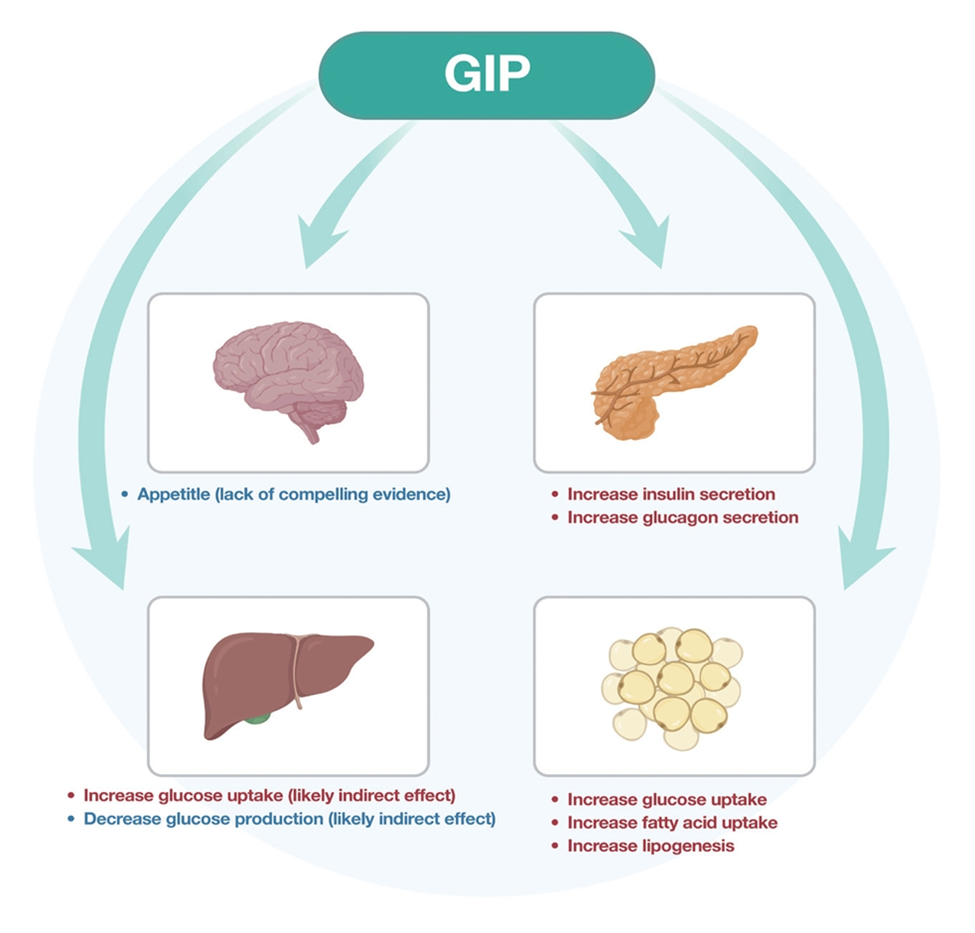
Glukagon
Glukagon ist ein Hormon, das als Gegenspieler zu Insulin funktioniert. Während Insulin die Nährstoffspeicherung nach dem Essen fördert, wird Glukagon während des Fastens oder bei niedrigem Blutzuckerspiegel aktiviert. Es löst die Mobilisierung der internen Energiereserven aus: den Abbau von Glykogen in der Leber, die Einleitung der Lipolyse (Fettabbau) und die Stimulation der Glukoseproduktion aus Aminosäuren.
Wenn die Glukagonrezeptoren künstlich aktiviert werden — wie bei Retatrutide — erhöht der Körper den Energieverbrauch, selbst im Ruhezustand. Die Lipolyse intensiviert sich, sodass Fett, das im Fettgewebe gespeichert ist, abgebaut und als Energiequelle genutzt wird.
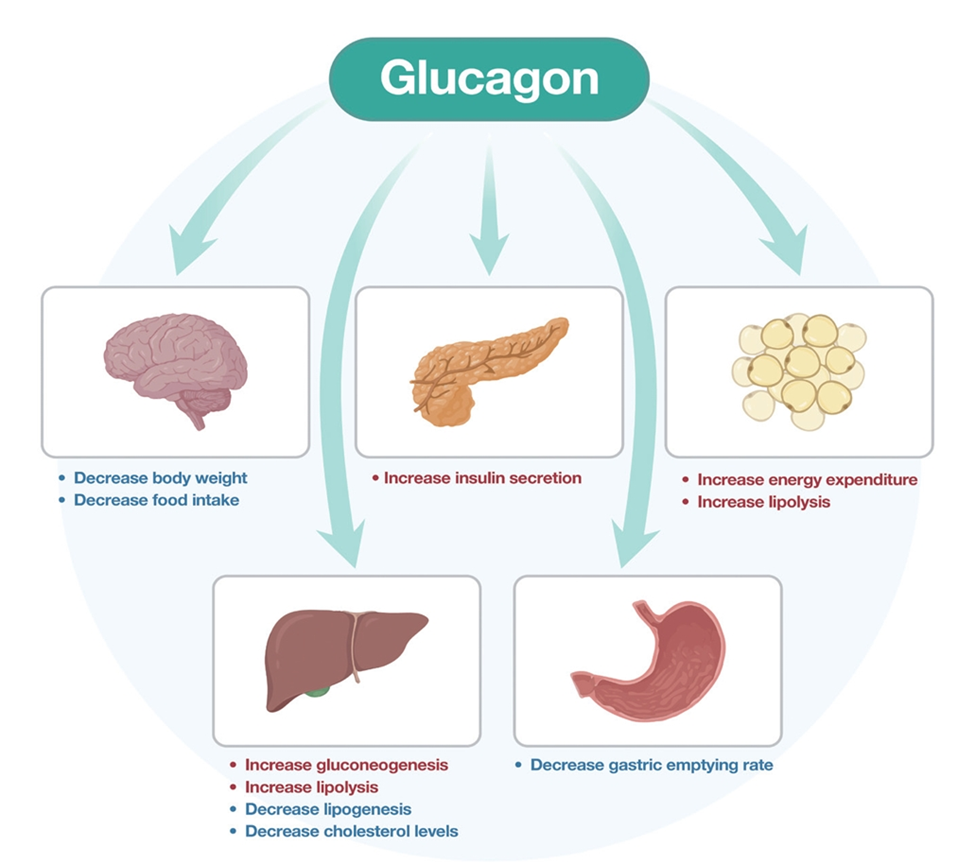
Retatrutide vs Semaglutide vs Tirzepatide
Semaglutide, Tirzepatide und Retatrutide gehören alle zur gleichen Arzneimittelklasse — sie zielen auf Hormone ab, die am Appetit, der Glukoseregulation und dem Energiehaushalt beteiligt sind. Aber sie unterscheiden sich grundlegend in ihrer Wirkungsweise, und Studien zeigen Unterschiede in den klinischen Ergebnissen. Wenn Sie den Kauf von Retatrutide in Betracht ziehen und seine Kosten mit anderen Medikamenten zur Gewichtsreduktion vergleichen, ist es wichtig zu verstehen, wie sich diese drei Medikamente in Bezug auf Wirkmechanismus und Wirksamkeit unterscheiden — und welches am besten zu Ihren Zielen passen könnte.
Kurz gesagt:
- Semaglutide wirkt auf einen Rezeptor (GLP-1)
- Tirzepatide zielt auf zwei (GLP-1 und GIP)
- Retatrutide aktiviert drei (GLP-1, GIP und Glukagon)
| Medikament | Aktivierte Rezeptoren | Haupteffekte | Durchschnittliche Gewichtsreduktion (klinische Daten) |
|---|---|---|---|
| Semaglutid | GLP-1 | Appetithemmung, verlangsamte Magenentleerung, Blutzuckerkontrolle | Bis zu ~15% über 68 Wochen |
| Tirzepatid | GLP-1 + GIP | Appetit, Blutzucker, Insulinreaktion, Fettstoffwechsel | Bis zu ~22,5% über 72 Wochen |
| Retatrutid | GLP-1 + GIP + Glukagon | Alles oben Genannte + Energieverbrauch und verstärkte Fettverbrennung | Bis zu ~24% über 48 Wochen |
Retatrutide befindet sich derzeit in Phase 3 der klinischen Studien, wobei die früheren Phasen bereits erfolgreich abgeschlossen wurden. Es hat in menschlichen Studien starke Ergebnisse gezeigt, ohne größere Nebenwirkungen, was es zu einem vielversprechenden Kandidaten für eine zukünftige Zulassung als neue medizinische Behandlung macht.
FAQ
Welche potenziellen Vorteile hat Retatrutide?
Gewichtsreduktion, verbesserte Blutzuckerkontrolle, verringerter Appetit.
Kann Retatrutide mit anabolen Steroiden kombiniert werden?
Ja, das ist möglich. Niedrige Dosen von Retatrutide können zur Appetitkontrolle eingesetzt werden, besonders während Cutting-Phasen, in denen es wichtig ist, ein Kaloriendefizit einzuhalten.
Ist Retatrutide sicher?
Frühe Studien zeigen, dass es im Allgemeinen sicher ist, aber Langzeitdaten sind begrenzt.
Brauche ich ein Rezept für Retatrutide?
Ja, es handelt sich um ein verschreibungspflichtiges Medikament und erfordert ein ärztliches Rezept. Wenn Sie den Preis von Retatrutide vergleichen oder nach einem Retatrutide-Angebot suchen, stellt eine Bestellung bei uns sicher, dass Sie eines der wettbewerbsfähigsten Angebote erhalten. Bedenken Sie jedoch, dass es sich um ein verschreibungspflichtiges Produkt handelt und Sie beim Transport über Grenzen hinweg vorsichtig sein sollten, da die Vorschriften je nach Land variieren können.
Wie schnell werde ich Ergebnisse von Retatrutide bemerken?
Eine Appetitreduktion kann innerhalb der ersten 1–2 Wochen einsetzen. Sichtbarer Gewichtsverlust tritt typischerweise nach 3–4 Wochen auf, wobei sich die volle Wirkung über mehrere Monate aufbaut.


